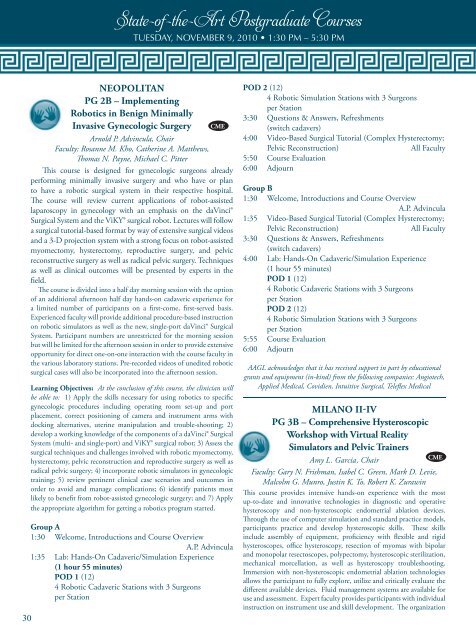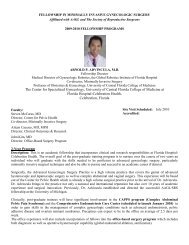39th AAGL Global Congress of Minimally Invasive Gynecology
39th AAGL Global Congress of Minimally Invasive Gynecology
39th AAGL Global Congress of Minimally Invasive Gynecology
Create successful ePaper yourself
Turn your PDF publications into a flip-book with our unique Google optimized e-Paper software.
30<br />
State-<strong>of</strong>-the-Art Postgraduate Courses<br />
NEOPOLITAN<br />
PG 2B – Implementing<br />
Robotics in Benign <strong>Minimally</strong><br />
<strong>Invasive</strong> Gynecologic Surgery CME<br />
Arnold P. Advincula, Chair<br />
Faculty: Rosanne M. Kho, Catherine A. Matthews,<br />
Th omas N. Payne, Michael C. Pitter<br />
Th is course is designed for gynecologic surgeons already<br />
performing minimally invasive surgery and who have or plan<br />
to have a robotic surgical system in their respective hospital.<br />
Th e course will review current applications <strong>of</strong> robot-assisted<br />
laparoscopy in gynecology with an emphasis on the daVinci®<br />
Surgical System and the ViKY® surgical robot. Lectures will follow<br />
a surgical tutorial-based format by way <strong>of</strong> extensive surgical videos<br />
and a 3-D projection system with a strong focus on robot-assisted<br />
myomectomy, hysterectomy, reproductive surgery, and pelvic<br />
reconstructive surgery as well as radical pelvic surgery. Techniques<br />
as well as clinical outcomes will be presented by experts in the<br />
fi eld.<br />
Th e course is divided into a half day morning session with the option<br />
<strong>of</strong> an additional afternoon half day hands-on cadaveric experience for<br />
a limited number <strong>of</strong> participants on a fi rst-come, fi rst-served basis.<br />
Experienced faculty will provide additional procedure-based instruction<br />
on robotic simulators as well as the new, single-port daVinci® Surgical<br />
System. Participant numbers are unrestricted for the morning session<br />
but will be limited for the afternoon session in order to provide extensive<br />
opportunity for direct one-on-one interaction with the course faculty in<br />
the various laboratory stations. Pre-recorded videos <strong>of</strong> unedited robotic<br />
surgical cases will also be incorporated into the afternoon session.<br />
Learning Objectives: At the conclusion <strong>of</strong> this course, the clinician will<br />
be able to: 1) Apply the skills necessary for using robotics to specifi c<br />
gynecologic procedures including operating room set-up and port<br />
placement, correct positioning <strong>of</strong> camera and instrument arms with<br />
docking alternatives, uterine manipulation and trouble-shooting; 2)<br />
develop a working knowledge <strong>of</strong> the components <strong>of</strong> a daVinci® Surgical<br />
System (multi- and single-port) and ViKY® surgical robot; 3) Assess the<br />
surgical techniques and challenges involved with robotic myomectomy,<br />
hysterectomy, pelvic reconstruction and reproductive surgery as well as<br />
radical pelvic surgery; 4) incorporate robotic simulators in gynecologic<br />
training; 5) review pertinent clinical case scenarios and outcomes in<br />
order to avoid and manage complications; 6) identify patients most<br />
likely to benefi t from robot-assisted gynecologic surgery; and 7) Apply<br />
the appropriate algorithm for getting a robotics program started.<br />
Group A<br />
1:30 Welcome, Introductions and Course Overview<br />
A.P. Advincula<br />
1:35 Lab: Hands-On Cadaveric/Simulation Experience<br />
(1 hour 55 minutes)<br />
POD 1 (12)<br />
4 Robotic Cadaveric Stations with 3 Surgeons<br />
per Station<br />
TUESDAY, NOVEMBER 9, 2010 • 1:30 PM – 5:30 PM<br />
POD 2 (12)<br />
4 Robotic Simulation Stations with 3 Surgeons<br />
per Station<br />
3:30 Questions & Answers, Refreshments<br />
(switch cadavers)<br />
4:00 Video-Based Surgical Tutorial (Complex Hysterectomy;<br />
Pelvic Reconstruction) All Faculty<br />
5:50 Course Evaluation<br />
6:00 Adjourn<br />
Group B<br />
1:30 Welcome, Introductions and Course Overview<br />
A.P. Advincula<br />
1:35 Video-Based Surgical Tutorial (Complex Hysterectomy;<br />
Pelvic Reconstruction) All Faculty<br />
3:30 Questions & Answers, Refreshments<br />
(switch cadavers)<br />
4:00 Lab: Hands-On Cadaveric/Simulation Experience<br />
(1 hour 55 minutes)<br />
POD 1 (12)<br />
4 Robotic Cadaveric Stations with 3 Surgeons<br />
per Station<br />
POD 2 (12)<br />
4 Robotic Simulation Stations with 3 Surgeons<br />
per Station<br />
5:55 Course Evaluation<br />
6:00 Adjourn<br />
<strong>AAGL</strong> acknowledges that it has received support in part by educational<br />
grants and equipment (in-kind) from the following companies: Angiotech,<br />
Applied Medical, Covidien, Intuitive Surgical, Telefl ex Medical<br />
MILANO II-IV<br />
PG 3B – Comprehensive Hysteroscopic<br />
Workshop with Virtual Reality<br />
Simulators and Pelvic Trainers<br />
Amy L. Garcia, Chair<br />
CME<br />
Faculty: Gary N. Frishman, Isabel C. Green, Mark D. Levie,<br />
Malcolm G. Munro, Justin K. To, Robert K. Zurawin<br />
Th is course provides intensive hands-on experience with the most<br />
up-to-date and innovative technologies in diagnostic and operative<br />
hysteroscopy and non-hysteroscopic endometrial ablation devices.<br />
Th rough the use <strong>of</strong> computer simulation and standard practice models,<br />
participants practice and develop hysteroscopic skills. Th ese skills<br />
include assembly <strong>of</strong> equipment, pr<strong>of</strong>i ciency with fl exible and rigid<br />
hysteroscopes, <strong>of</strong>fi ce hysteroscopy, resection <strong>of</strong> myomas with bipolar<br />
and monopolar resectoscopes, polypectomy, hysteroscopic sterilization,<br />
mechanical morcellation, as well as hysteroscopy troubleshooting.<br />
Immersion with non-hysteroscopic endometrial ablation technologies<br />
allows the participant to fully explore, utilize and critically evaluate the<br />
diff erent available devices. Fluid management systems are available for<br />
use and assessment. Expert faculty provides participants with individual<br />
instruction on instrument use and skill development. Th e organization







